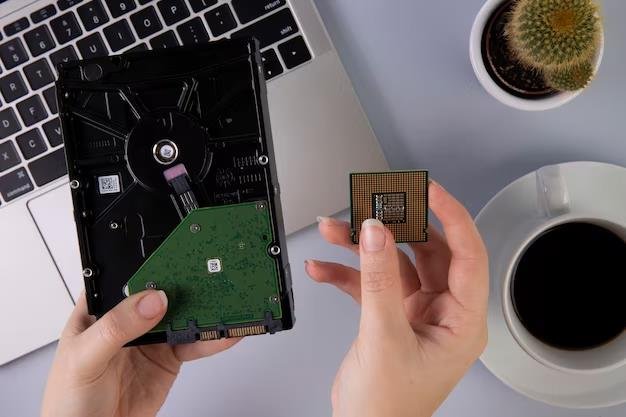Memory chips are essential components of all electronic devices, from computers and smartphones to cars and industrial equipment. They are used to store data and instructions that are needed for the devices to function. There are many different types of memory chips available, each with its own unique characteristics.
In this guide, we will explore different types of memory chips and their key features to help you make an informed choice.
Table of Contents
Types of Memory Chips
Memory chips come in various forms, each designed for specific tasks. Here are the most common types:
1. RAM (Random Access Memory)
Random Access Memory, or RAM, is a volatile memory chip that stores data temporarily while a device is in use. When you open an application on your computer or smartphone, the data required to run that application is loaded into RAM. RAM is much faster than long-term storage (like hard drives or SSDs) but is volatile, meaning it loses its data when the device is powered off. The two main types of RAM are Dynamic RAM (DRAM) and Static RAM (SRAM).
- DRAM: DRAM is the most common type of RAM. It’s used in laptops, desktops, and many other devices. It’s cheaper than SRAM but slower. It requires a constant electrical refresh to keep the data intact.
- SRAM: SRAM is faster and more expensive than DRAM. It’s often used in cache memory for CPUs and other high-performance applications. Unlike DRAM, it doesn’t require constant refreshing, making it faster but more power-hungry.
2. ROM (Read-Only Memory)
Read-only memory, or ROM, is a non-volatile memory chip that stores data permanently and cannot be modified. It contains firmware and software that is essential for a device’s operation. There are different types of ROM, such as:
- PROM (Programmable ROM): This type can be programmed once using a special device, and the data remains fixed.
- EPROM (Erasable Programmable ROM): EPROM can be erased and reprogrammed multiple times, but it requires exposure to ultraviolet (UV) light for erasure.
- EEPROM (Electrically Erasable Programmable ROM): EEPROM can be erased and reprogrammed electronically, making it more user-friendly for updates.
- Flash Memory: Flash memory is a type of EEPROM that’s widely used in devices like USB drives, SSDs, and memory cards. It allows for fast and easy data storage and retrieval.
3. NVRAM (Non-Volatile RAM)
Non-volatile RAM combines the speed of RAM with the non-volatility of ROM. It retains data even when the power is turned off. NVRAM is often used in critical applications such as storing BIOS settings in a computer.
4. Cache Memory
Cache memory is a small, high-speed volatile memory chip that sits between the main RAM and the CPU. Its primary function is to store frequently accessed data, speeding up data retrieval for the CPU. There are generally three levels of cache memory in a modern CPU, with L1 being the closest and fastest to the CPU, followed by L2 and L3.
5. Optane Memory
Intel’s Optane Memory is a new type of non-volatile memory that combines the speed of RAM with the capacity of SSDs. It’s often used as a caching drive to accelerate the performance of traditional hard drives or slower SSDs in desktops and laptops.
Key Features to Consider
When selecting memory chips for your application, several key features need to be taken into account to ensure the best performance and reliability. These features include:
1. Capacity
The capacity of the memory chip determines how much data it can store. For RAM, more capacity means you can run more applications simultaneously without slowing down your device. In the case of ROM, it defines how much firmware or data can be stored permanently.
2. Speed
The speed of a memory chip is crucial for performance. In the case of RAM, the speed is typically measured in megahertz (MHz) or gigahertz (GHz). Faster RAM allows for quicker data retrieval and better multitasking capabilities. For non-volatile memory like ROM and flash memory, speed affects how quickly data can be read and written.
3. Durability
For applications where memory chips are subject to extreme conditions, such as in industrial settings or space exploration, durability is a critical factor. Memory chips should be able to withstand temperature variations, shock, and vibration.
4. Endurance
The endurance of a memory chip is especially important for non-volatile memory like flash memory. It indicates how many write/erase cycles the chip can endure before it starts to degrade. Higher endurance is essential for devices that perform frequent read and write operations, such as SSDs.
5. Data Retention
For non-volatile memory, data retention is a crucial factor. It defines how long data can be stored on the chip without power. Longer data retention is essential for archival and critical data storage.
6. Compatibility
Ensure that the memory chip you choose from an electronic parts supplier is compatible with your device’s interface. Common interfaces for memory chips include DDR (Double Data Rate) for RAM and SATA or NVMe for SSDs.
7. Cost
Cost is always a consideration. High-performance memory chips, such as high-speed RAM or high-capacity SSDs, tend to be more expensive. It’s essential to strike a balance between performance and budget when selecting memory chips for a project.
8. Power Consumption
Power efficiency is crucial, especially for mobile devices and data centers. Memory chips should consume as little power as possible to extend battery life and reduce operating costs.
Final Thoughts
Memory chips are the backbone of modern computing and data storage. Selecting the right type and features for your application is vital to ensure optimal performance and reliability. Whether you’re upgrading your computer’s RAM, choosing a high-speed SSD for your laptop, or selecting non-volatile memory for an embedded system, understanding the different types and key features of memory chips will help you make an informed decision. As technology continues to advance, memory chips will continue to evolve, offering faster speeds, higher capacities, and improved reliability, making them even more critical in our increasingly data-driven world.
FAQs
1. What is a memory chip?
A memory chip is an integrated circuit that stores data.
2. What are the 3 types of memory chips?
The three types of memory chips are:
- Random access memory (RAM)
- Read-only memory (ROM)
- Flash memory
3. Where is the memory chip in a computer?
The memory chip is located on the motherboard of a computer.
4. What is the main memory chip called?
The main memory chip is called random access memory (RAM).





